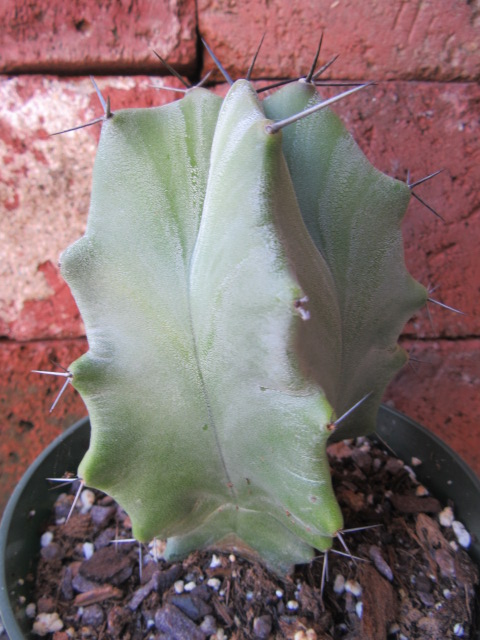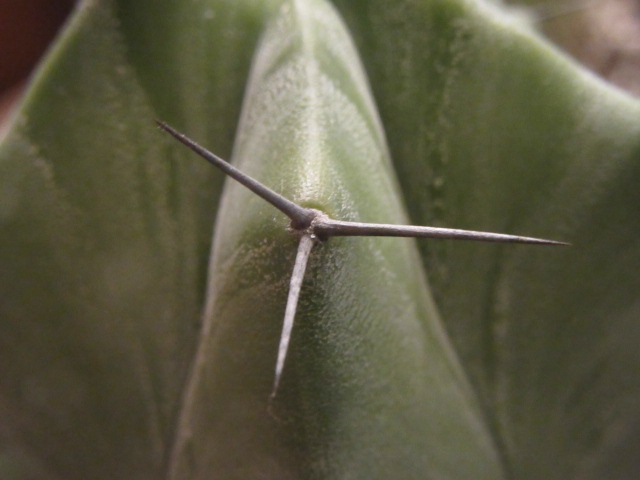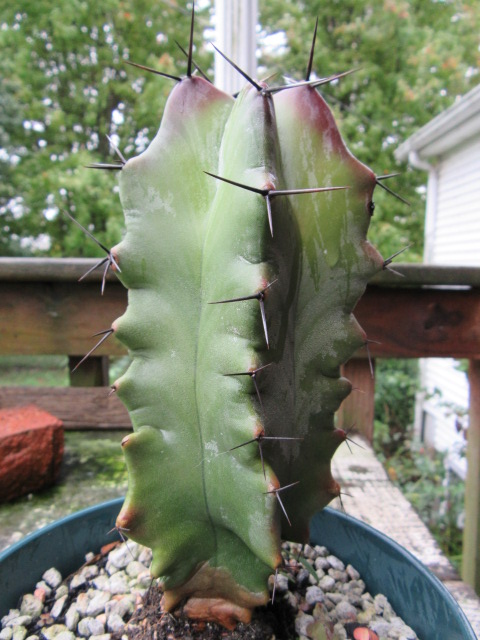
Stenocereus pruinosus on 7-19-16, #274-66.
Gray Ghost, Organ Pipe, Pitayo de Octubre (of October), Pitaya
Stenocereus pruinosus
sten-oh-KER-ee-us proo-in-NO-sus
Synonyms of Stenocereus pruinosus (20) (Updated on 12-10-23 from Plants of the World Online): Cactus pruinosus Monv. ex Steud.(1840), Cereus laevigatus Salm-Dyck (1850), Cereus pruinosus (Otto ex Pfeiff.) C.F.Först. (1846), Cereus roridus Pfeiff. (1837), Cereus schumannii Mathsson ex K.Schum. (1899), Echinocactus pruinosus Otto ex Pfeiff. *1837), Griseocactus pruinosus (Otto ex Pfeiff.) Guiggi 2012, Griseocereus pruinosus (Otto ex Pfeiff.) Guiggi (2012), Lemaireocereus laevigatus (Salm-Dyck) Borg (1951), Lemaireocereus pruinosus (Otto ex Pfeiff.) Britton & Rose (1920), Lemaireocereus schumannii (Mathsson ex K.Schum.) Britton & Rose (1909), Neogriseocereus pruinosus (Otto ex Pfeiff.) Guiggi (2013), Pachycereus schumannii (Mathsson ex K.Schum.) C.Nelson (2001), Rathbunia laevigata (Salm-Dyck) P.V.Heath (1992), Rathbunia laevigata var. schumannii (Mathsson ex K.Schum.) P.V.Heath (1992), Rathbunia pruinosa (Otto ex Pfeiff.) P.V.Heath (1992), Ritterocereus laevigatus (Salm-Dyck) Backeb. (1960), Ritterocereus pruinosus (Otto ex Pfeiff.) Backeb. (1951), Stenocereus laevigatus (Salm-Dyck) Buxb. (1961), Stenocereus laevigatus var. schumannii (Mathsson ex K.Schum.) P.V.Heath (1996)
Stenocereus pruinosus (Otto ex Pfeiff.) Buxb. is the accepted scientific name for this cactus. It was described by this name by Franz Buxbaum in Botanische Studien in 1961. It was first named and described as Echinocactus pruinosus by Christoph Friedrich Otto and Louis (Ludwig) Karl George Pfeiffer in Enumeratio Diagnostica Cactearum in 1837.
The genus, Stenocereus (A.Berger) Riccob., was named by Vincenzo Riccobono and first mentioned in Bollettino delle Reale Orto Botanico di Palermo in 1909. It replaces Cereus subsp. Stenocereus that was named by Alwin Berger and first mentioned in the Annual Report of the Missouri Botanical Garden in 1905.
As of 12-10-23 when this page was last updated, Plants of the World Online by Kew lists 21 species in the Stenocereus genus. It is a member of the plant family Cactaceae with 150 genera. Those numbers could change as updates are made on POWO.
THERE ARE SEVERAL LINKS AND GROWING RECOMMENDATIONS AT THE BOTTOM OF THE PAGE FOR FURTHER READING.

Stenocereus pruinosus on 5-31-17, #339-41.
I brought my Stenocereus pruinosus home from Walmart on 2-1-16. It was growing in a 2 1/2” (4 oz.) pot and it measured approximately 2 7/8” tall x 2 3/4” wide at the time. The label states:
“Lemaireocereus pruinosus is a powdery, gray columnar cactus that grows to 20’ in height in time. White nocturnal flower. Native habitat is Puebla, Mexico. Protect from frost. Provide bright light/sun; hardy to 32 degrees F.; to 6’ tall. Water thoroughly when soil is dry.”
Of course, Lemaireocereus pruinosus is not the correct name now…

Stenocereus pruinosus on 9-5-17, #371-22.
Stenocereus pruinosus can be found in its native habitat in Chiapas, Guerrero, Oaxaca, Puebla, and Veracruz in Mexico at 2,600 to 6,200 feet (800 to 1,900 meters) above sea level where they grow in tropical deciduous forests. They are known for their edible fruit.

Stenocereus pruinosus on 10-17-17, #384-24.
When I brought my plants in for the winter on October 17, 2017, the Stenocereus pruinosus measured 3 3/4″ tall x 2 3/4″ wide. Ummm… That measurement may have included the spines which I later ignored when taking measurements.

Stenocereus pruinosus, from the top, on 10-17-17, #384-25.
Stenocereus pruinosus grows to become a large shrubby or tree-like cactus. Stems usually have one or more trunks that can grow to 13-16 feet (4-5 meters) tall and a little over 3” to about 4” ( 8-10 cm) in diameter. They normally have 5-6 ribs but can have as many as 8-10, that are widely set and have wavy margins. The areoles are normally around 1 1/2” (3-4 cm) apart and produce 1-4 small grayish to brownish central spines and 5-8 smaller radial spines that are the same color. When it flowers, they come from new growth on the tips of the stems.
<<<<2018>>>>

Stenocereus pruinosus on 1-18-18, #401-13.
Doing very well inside for the winter, the Stenocereus pruinosus was snuggled with many other cacti and succulents on a table in my bedroom when the above photo was taken. They were getting lots of good sun from a south-facing window.

Stenocereus pruinosus on 5-17-18, #443-98.
Back outside again for the summer…

Stenocereus pruinosus on 7-29-18, #487-96.
After the Japanese Beetle invasion, I moved the potted plants, cactus, and succulents to the front and back porch of the house. The Stenocereus pruinosus is enjoying its summer in the sun on the back porch.
I had to move the potted plants inside for the winter on October 10 because the forecast was calling for an “F” in a few days and the nighttime temperatures were getting cooler. The Stenocereus pruinosus measured 3 7/8″ tall x 3″ wide but I forgot to take its photo… GEEZ!

Stenocereus pruinosus on 11-29-18, #534-33.
November 29 was a nice spring-like day, so I took the cactus to the back porch for a photoshoot. I was working on a post to show the difference between the cactus in my collection.

Stenocereus pruinosus close-up on 12-1-18, #535-24.
Stenocereus pruinosus is a very interesting plant for sure. Its areoles produce 1-4 short and stout central spines. Llifle also says they have 5-8 radial spines… My cactus has 2-4 spines on its areoles, usually 3, but it is hard to say if they are radial spines or central spines… The dusty-white appearance is from the “bloom” which is a characteristic of this species.
<<<<2019>>>>

Stenocereus pruinosus on 6-22-19, #593-43.
All the plants made it through the winter and were glad to be outside for the summer. I put the Stenocereus pruinosus and most of the other cacti on the back porch.
I was fairly busy over the summer so I didn’t take a lot of photos of the potted plants. They all did very well despite a little neglect.

Stenocereus pruinosus at 4 3/4″ tall x 2 3/4″ wide on 10-11-19, #639-89.
The next thing I knew, I had to move the potted plants inside for the winter on October 11 because an “F” was in the forecast. I always take photos of the plants when I move them inside and measure the cactus and some of the succulents. The Stenocereus pruinosus measured 4 3/4″ tall x 2 3/4″ wide. That’s pretty good considering it was only 2 7/8″ tall when I brought it home on February 1, 2016. At least I didn’t forget its photo this time…
<<<<2020>>>>

Stenocereus pruinosus (Gray Ghost) at 5 1/4″ tall x 2 3/4″ wide on 10-15-20, #747-100.
I had to move the potted plants inside for the winter on October 15 because an “F” was in the forecast. As always, I take photographs and measurements of the cactus when I bring them in. The Stenocereus pruinosus did very well over the summer and measured 5 1/4″ tall x 2 3/4″ wide on October 15.

Stenocereus pruinosus (Grey Ghost) from the top on 10-15-20, #747-101.
The above photo is a top view of the Stenocereus pruinosus sporting a purplish glow from being in the sun.
<<<<2021>>>>

Stenocereus pruinosus (Gray Ghost) at 6 3/8″ tall x 3 1/8″ wide on 10-28-21, #853-29.
I didn’t have to move the potted plants inside for the winter until October 28 in 2021. There wasn’t a chance of an “F” in the forecast until then which was quite unusual. The Stenocereus pruinosus always does great over the summer and grew to 6 3/8″ tall x 3 1/8″ wide. I really like this plant…
USEFUL INFORMATION:
Family: Cactaceae
Origin: Oaxaca, Puebla, and Veracruz in Mexico
Zones: USDA Zones 9b-11(25 to 40° F)
Size: 10-20’… UMMM…
Light: Sun to light shade
Soil: Very well-draining. Good quality potting soil amended with pumice (50/50) or additional perlite and chicken grit (2-1-1).
Water: Average during the summer months, barely during the winter.
You can read my Cactus Talk & Update and Cactus & Succulent Tips to get my opinion about growing cacti and succulents.
When you bring your new plants home from the store, you need to check their roots and the soil to see if they are wet. If so, you may want to re-pot it right away. It is advisable to re-pot them in a better potting soil that is more suitable for cacti and succulents.
<<<<2022>>>>

Stenocereus pruinosus (Gray Ghost, Organ Pipe, Etc.) at 6 1/4″ tall x 3 1/8″ wide on 10-16-22, #919-35.
I had to move the potted plants in the winter on October 16 in 2022 because a “you know what” was in the forecast. I put the cacti on the front porch with the succulents in the spring to give them a little more shade. The Stenocereus pruinosus is still alive and well. It measured 6 1/4″ tall x 3 1/8″ wide which is down a little in height from last year.
<<<<2023>>>>

Stenocereus pruinosus (Gray Ghost/Organ Pipe) at 7 1/4″ tall x 3 1/4″ wide on 10-23-23, #967-36.
Even though there was no “F” in the forecast until October 30, it was going to be a rainy week so I moved the potted plants inside on the 23rd and 24th. Time for photos and measurements…
The Stenocereus pruinosus did very well during the summer on the back porch in full sun despite the heat and drought. It measured 7 1/4” tall x 3 1/4” wide when I moved it inside for the winter.

Stenocereus pruinosus Gray Ghost) on 10-23-24, #967-37.
Hmmm… It appears to have a new scar. I wonder what did that?
I have really enjoyed the Stenocereus pruinosus as a companion and I think it is a great-looking specimen. It is much different than the other cactus in my collection. I like the silver color of the bloom and the way it gets darker with more light. There is also a variegated variety of this cactus, which would be very interesting.
I hope you enjoyed this page and maybe found it useful. If you have any comments, questions, or suggestions, I would like to hear from you. Please click on “like” if you visited this page. It helps us bloggers stay motivated. 🙂 You can check out the links below for further reading. The links take you directly to the genus and species of this plant.